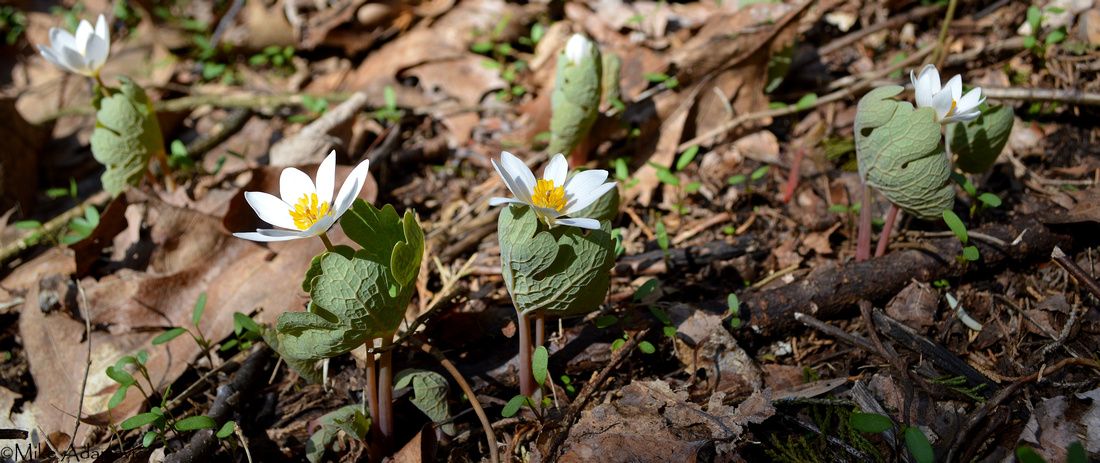Bloodroot (Sanguinaria canadensis)


Quickly after the last of the winter snow has dissipated and a flattened, tawny earth emerges to greet the first rays of the spring sun, certain streamsides and other moist areas throughout our region find themselves covered once more with a dense layer of white. This time the cloak originates from beneath the newly warmed ground, rather than the upper reaches of the chilled atmosphere. Bloodroot, an uncommon spring ephemeral, whose ivory petals surround a bright, golden center, is one of the earliest wildflowers to be awakened by even the most minimal of April heat, eager to bask in the untapped reserve of sunshine now flooding every nook and cranny of the understory.
As the name portrays, these plants do indeed possess crimson roots. Moreover, this species bleeds the same as any injured animal. A broken leaf or stem will cause the plant to exude a fluid alarmingly similar to blood. It stains anything it touches, and has been used in years past as a dye by both Native Americans and Colonists.
Additionally, root extracts have historically been used to treat a wide variety of ailments ranging from cancer to lung disease to sore throats. And up until recently, it was even employed as an ingredient in Viadent toothpaste to combat gum disease and the build-up of plaque. At the moment, though, the efficacy of bloodroot on anything health related is dubious at best. Numerous sources relate that the root is toxic, and even coming in contact with its juices can cause dermatitis, similarly to poison ivy. It’s hard to believe it was ever consumed—the root’s taste is so acrid that a minor quantity can induce vomiting. Some concoctions were once made more palatable by adding copious quantities of sugar. This is probably one plant that should be appreciated by sight alone.
When it comes to habitat, plants prefer moist, rich soils, having an inclination to grow along gently sloping banks. More often than not, they will be found along some type of water body, be it a river, lake, or even a temporary rivulet born of snowmelt. While one of the loveliest flowers of the early spring, it also lives up to the category of wildflowers it’s grouped into exceedingly well (spring ephemerals). Trying to locate an intact specimen requires razor-sharp precision time-wise. With flowers usually lasting no more than a few days, it certainly is imbued with a fleeting nature. Plants will only produce a single blossom, which once lost, will not attain another until the following spring. Typical bloom dates are from mid-April to early May.
Like many other spring ephemerals, bloodroot uses ants as a means of seed dispersal, a technique known as myrmecochory. Each tiny seed is equipped with a lipid-rich appendage called an elaiosome. This tempting morsel entices ants to transport the seed back to their nest where they remove the elaiosome and discard the seed body in waste pits that provide an enriched medium for growth. In this way, bloodroot is able to colonize new locales away from the parent plant and ensure optimal germination.
Usually found in small groups or clusters, large colonies can develop, containing in excess of several hundred individuals, the result of vegetative propagation, another form of reproduction which produces clones by extension of the rhizomes, or roots.


With bloodroot awakening much sooner than other plants, the large blossoms, as well as the glaucous, almost succulent leaves, create a striking scene among the withered foliage and broken stems of last year’s growth. A particularly large, showy grove is easily spotted at a considerable distance and visually eclipses other ephemeral populations that attain a similar size. There’s something entrancing and fairy-like in the demeanor of these uncommon flowers, with their unique ability to pop up seemingly overnight, transforming the landscape like magic. Such vigor and color contrasts greatly with the bleak debris that surrounds, creating an image of surpassing beauty that’s sure to be emblazoned in memory and sought out year after year.


Amid the briar copses, of sunny vales
And moist streamsides; awakened
As suddenly upon the beat of quails,
A purity surpassing newly fallen snow
Richly carpets the earth—a beauty,
I thought I’d surely never know.
A lingering moment viewing,
Singular works as these,
Stops all worthless ruing
And fills the heart with ease.
Those cheerful, ivory blooms
Whose being is a smile,
Sweep away better than a broom,
Debris of cluttered forest aisle,
And like the crimson dye
That lends the plant its name,
It stirs the blood of every passerby
And is more worthy of fame—
Than ordinary garden denizens.